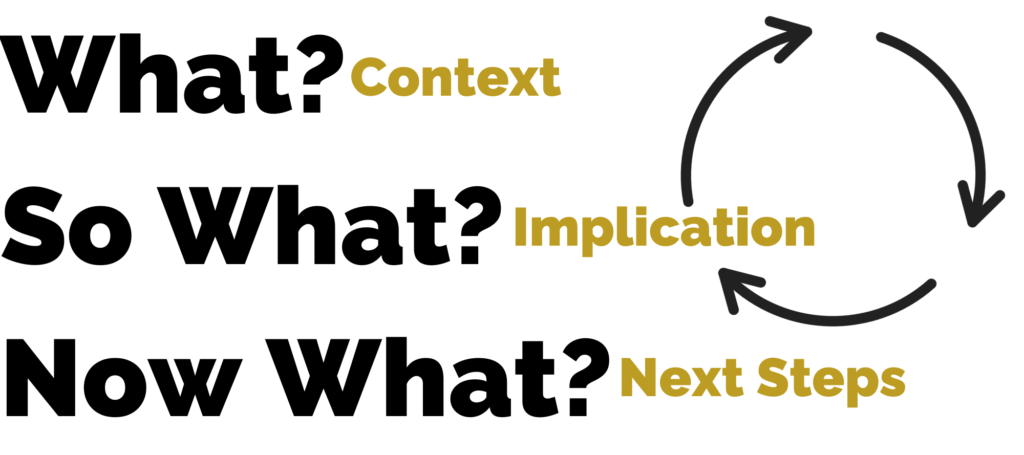Let’s Practice Reflection
By Maggie Kuhn (’21), Assistant Director, Mentoring and Alumni Personal & Career Development at Wake Forest University
The society we live in is increasingly engineered for productivity. Self checkout lanes, drive-through restaurants, online shopping – all efficiencies meant to keep up the pace, to save us from wasting time and labor, and encourage us to move quickly to the next place where we will produce, do, buy, sell, or consume again.
Don’t get me wrong; there are some significant pros to these luxuries. I’ll admit, a great online sale isn’t lost on me, and I’ll make my way to a self-checkout line from time to time. Some solutions to increase efficiency, like online shopping, can be great for providing access to resources and optimizing processes in our day-to-day lives. The issue sets in when all we are is a consumer, doer, or producer.

It is likely that many of us have found ourselves just going through the motions, stuck in some variation of a rut. When things get busy, we may glaze over the pieces of our everyday lives that bring newness, opportunity, growth, or space. There are relationships to be built, lessons to be learned, patterns to be broken, sights to be seen, rest to be had, and growth to be done. All we have to do is find the time to regularly give ourselves a moment or two to mindfully slow down and reflect.
Reflection is the key. It’s the secret sauce that helps us keep moving forward by allowing us to critically analyze and digest our lived experiences. Reflection is a self-driven process of learning and growth based on non-judgmental curiosity and intentional thought. By engaging with reflection, we identify our values, intentions, thoughts, and feelings. We are able to define our own goalposts and guardrails and restore a sense of purpose and meaning to our lives. We gain the ability to more clearly make decisions, solve problems, and set goals. Reflection allows us to develop self-awareness, emotional intelligence, and general clarity in life, just by leveraging the happenings of our everyday lives.

There are many methods of reflection available to us: journaling, artistic expression, meditation, receiving feedback from a trusted source, the SWOT analysis method, and many more. It’s important to be open-minded to find what method works best for you and make it a habit. One of my personal favorite ways to reflect is to follow a technique that guides reflection on a situation or experience by defining the context, implications, and next steps. All by answering three questions: What? So What? Now What?
First, you start with “What?” Ask yourself to define the experience. Spend this time to focusing on the facts.
What happened?
What is the context?
Who is involved?
What are their roles?
Then, you figure out the implications with the “So What?” This reflective stage prompts you to process more of the thoughts and emotions around the experience.
Why does this matter?
What is the significance of this experience?
What does this mean for me?
What emotions am I experiencing?
What are my thoughts and feelings in this situation telling me about myself?
So what is the new goal?
What might I need to change?
Last, you ask yourself “Now What?” This is when you come up with an action plan. Try out your next steps, and remember that you can always cycle through these three questions again.
Given the context and the implication of this situation, what do I do now?
In order to continue, what needs to happen?
Who might I need to include?
What is one thing I can do now to start?
Being able to practice reflection and engage with introspective thought is a vital skill, but there are always roadblocks. Many people have trouble facing the challenging truths and more difficult emotions that come with the vulnerability in reflection. It can also be difficult to find the time to sit down and reflect, especially when we have busy schedules, unsupportive work environments, high-pressure careers, or responsibilities that require constant attention, like chronic illness, caregiving for elderly adults, or raising children.
Reflection understandably takes a back seat when there are more pressing issues to handle, but there are ways to implement more reflection into your life and reap these benefits without sacrificing your livelihood. Think about how you can build a new reflective practice into your current routine and make it a habit.

Try a ritual self-check-in every day while you brush your teeth or take a shower. Call a friend or family member on your daily commute. Set a reminder on your phone to journal for 15 minutes every Sunday afternoon. Even take a few minutes before bed to stretch your body and recount the events of your day. Once you begin to pay attention to patterns, emotions, and ideas that come up, you will see the benefits of reflection start to unfold in your life.
Whatever method of reflection you choose, the most important thing is that your practice is yours. Reflection is a personal process, and you are the only one that can decide what that means for you. Figure out what works for your needs, and stick with it!
Although taking time for abstract thought is not always one of our top priorities, with a little bit of effort and intention, small shifts now can lead to big waves of positive change later.
